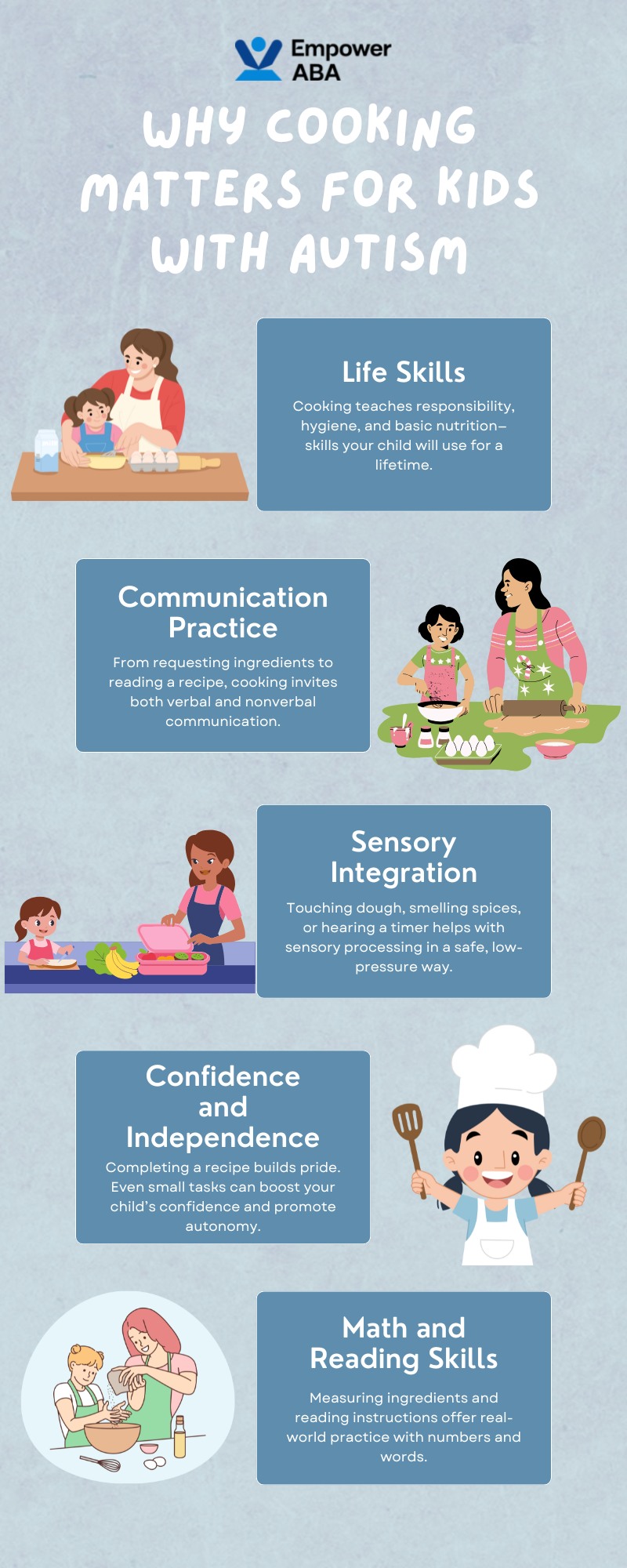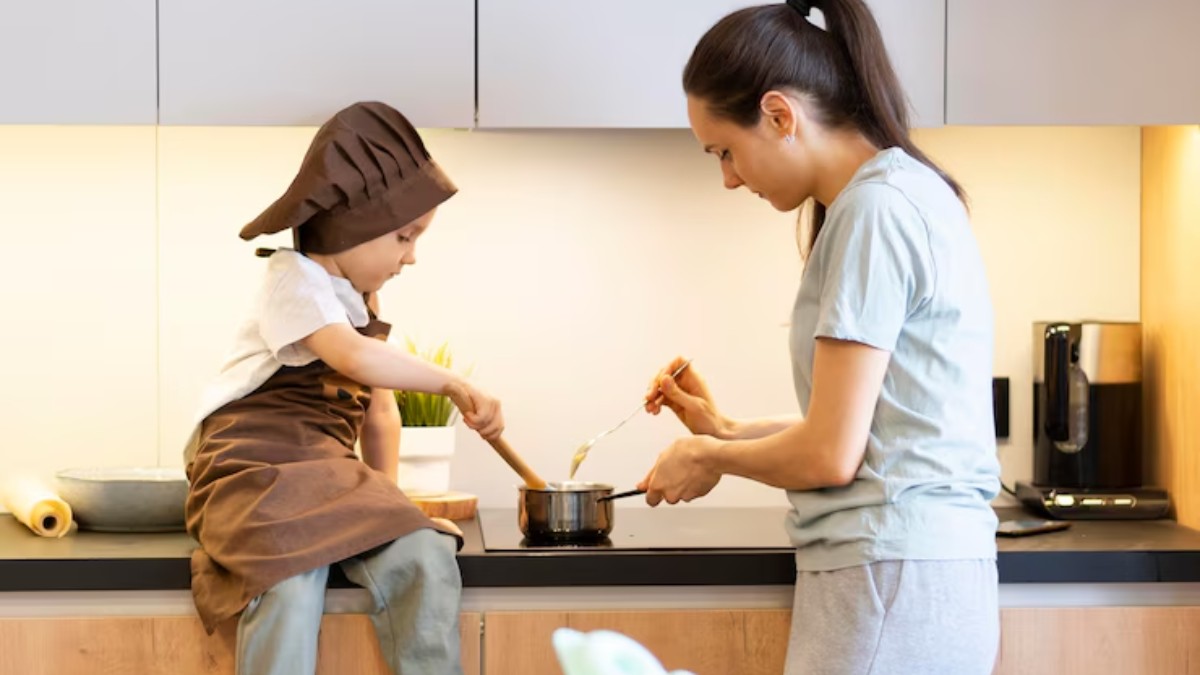Key Points:
- Cooking can be a meaningful and manageable activity for children with autism, with the right structure and support.
- Practical strategies like visual schedules, sensory-friendly tools, and simplified recipes can make cooking more enjoyable.
- Parents can use cooking as a teaching moment to boost life skills, independence, and confidence.
For many families navigating autism, the kitchen can be both a challenge and a place of growth. With the right strategies and tools, cooking autism-friendly meals can become a joyful and educational experience. Let’s explore how families can make the most of cooking time with their autistic child, while building life skills that go far beyond the kitchen.
Can Kids With Autism Really Cook?
Yes, absolutely. With the right support, many children with autism can enjoy and excel in cooking activities. Every child has unique strengths and challenges, but cooking can be tailored to suit various needs and comfort levels.
Cooking is a hands-on way to help children with autism build independence, develop fine motor skills, and learn about routines. It offers predictability (recipes), structure (steps), and reward (eating the final product), which are all positive elements for children on the spectrum. With patience and the right approach, the kitchen can become a powerful tool for growth and bonding.
Why Cooking Matters For Kids With Autism
Cooking does more than fill plates—it builds skills. Before diving into how-to tips, it’s helpful to understand what children gain from cooking regularly.

Cooking involves a mix of sensory experiences, social interaction, and following steps—all areas where children with autism can benefit from gentle practice. When integrated into family routines, cooking becomes a consistent, goal-oriented activity that supports learning and development, much like other holistic approaches that aim to strengthen core skills—such as those discussed in Exploring Amino Acid Therapy in Autism Management.
How To Get Started: Creating A Safe And Comfortable Kitchen Space
Helping your child feel at ease in the kitchen starts with creating a sensory-friendly and structured environment. A few thoughtful adjustments can make a big difference in how your child interacts with cooking.
Set Up For Success
Start with small changes and clear expectations. These quick tips will help you prep your kitchen for cooking autism-friendly recipes:
- Use visual schedules: Display steps of the recipe with pictures or simple words to show what comes next.
- Establish a workstation: Pick one counter or table area for all cooking activities to create routine and predictability.
- Minimize clutter: Keep only what you need within reach to reduce distractions.
- Allow breaks: Let your child know it’s okay to pause if overwhelmed by noise or smells.
Sensory-Friendly Tools
Some kitchen tools and textures might be uncomfortable for a child with autism. Here are tools that can help reduce discomfort and improve participation:
- Silicone utensils that are soft and quiet
- Noise-canceling headphones if your child is sensitive to kitchen sounds
- Non-slip bowls and cutting boards to improve stability
- Gloves or tongs for kids who prefer not to touch food directly
Practical Tips For Cooking With Autism
Each child’s experience with cooking autism-friendly meals will look different. The key is to personalize the approach to suit your child’s unique sensory and cognitive profile.
Start Small With Simple Recipes
Keep things achievable. Look for no-bake or minimal-step recipes with visual cues. Great starter ideas include:
- Fruit kabobs
- Sandwiches with shaped cookie cutters
- DIY trail mix
- Pita pizzas with toppings your child can choose
These kinds of recipes allow for creativity and choice, which boosts engagement.
Use Visuals And Checklists
Visual aids are powerful tools for many children with autism. Consider using:
- Step-by-step recipe cards with pictures
- Laminated checklists they can mark off
- Color-coded utensils to match recipe steps
These supports reduce anxiety and help your child understand what to expect.
Make It A Routine
Consistency helps kids thrive. Try cooking on the same day each week, or prepare one familiar dish each time to build comfort. Predictable routines make participation easier over time.
Encourage Participation At Their Level
Not every child will want to cook from start to finish—and that’s okay. Let your child choose tasks they enjoy:
- Pouring or stirring
- Washing produce
- Peeling bananas
- Spreading sauce
Letting your child lead where possible fosters autonomy and comfort.
When Things Don’t Go As Planned
Setbacks are part of the process, and it’s okay if things don’t go perfectly. Stay calm and supportive.
If your child gets overwhelmed:
- Offer a break or a quiet corner
- Use calming language and visual cues
- Focus on what went well rather than what didn’t
Remember, the goal is engagement, not perfection.
Helpful Resources For Cooking Autism-Friendly Meals
There are many tools and communities available to help support cooking autism practices at home. Here are a few parent-friendly resources to explore.
Recommended Tools And Materials
- Visual recipe apps like “Look, Cook and Eat” designed for neurodiverse users
- Cookbooks for kids with autism, such as “The Autism Cookbook” by Elizabeth Strickland
- Sensory cooking kits that include adapted utensils and visual guides
Online Communities
Support from other families can make a big difference. Consider joining:
- Autism parenting forums with cooking threads
- Facebook groups dedicated to autism and daily activities
- Local support networks or community centers that offer life skills workshops
ABA Therapy And Cooking: A Natural Partnership
Cooking builds real-life skills that reinforce the behavioral goals many children work on during Applied Behavior Analysis (ABA) therapy. From turn-taking to task completion, cooking is a practical way to strengthen progress made in therapy.
If you’re looking to help your child develop life skills like cooking in a supportive and structured environment, Empower ABA is here to help. Empower ABA provides high-quality ABA therapy in Virginia, New York, and New Jersey, with a focus on empowering children through evidence-based practices.
To learn more about how Empower ABA can support your family and help your child thrive, get in touch today. Their compassionate team is ready to partner with you every step of the way.

